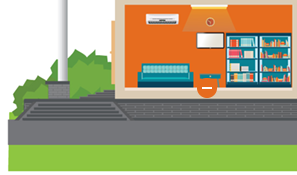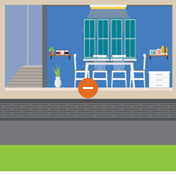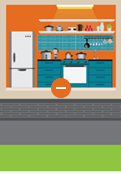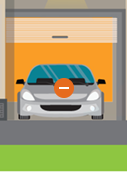Attic, Garage and Unconditioned Spaces
There are many unconditioned spaces in your home – attic, garage, utility room, etc. – which often get overlooked for energy-efficient and conservation measures. Let’s see what we can dig up!
Office and Electronics
In this digital age, electronics are found in every room of the house and many of them have energy-efficient settings. Check out our list below for more information.
Bedroom
Even while you sleep, your home can still use energy. Below we have outlined some tips on saving electricity and staying comfortable without breaking the bank.
Bathroom
This may not be a hot spot for energy efficiency, but there are ways to conserve energy without sacrificing comfort. Check those out below.
Living Room
From lighting to windows to your thermostat, the living room is a great place to make the most out of home energy savings. Read on to see how to reduce electricity bills in your main living space.
Miscellaneous
There are many more ways you can save energy that don’t necessarily fit into one particular room. We have you covered with more tips below.
Kitchen
Even with energy-efficient appliances, you can still learn how to save money on electric bills with the helpful tips you’ll find below.
HVAC – Heating, Ventilation and Air Conditioning
The majority of your energy usage comes from your HVAC system. Below we have outlined numerous tips to help you stay comfortable and maintain your system while lowering your utility bills.
Attics & Other Unconditioned Spaces (Unfinished Basements, Garages)
An energy-efficient home starts with proper insulation – especially in the attic. Insulation’s R-value tells you how effective it is at preventing heat transfer (with a maximum of R60). With our region’s chilly winters, most homeowners in OPPD’s service area would benefit from adding:
- R49 to R60 insulation to an uninsulated attic
- An additional layer R38 to R49 over existing attic insulation
Watch this video and check out the tips below for more information.
- Blown-in, loose-fill insulation is best in attic spaces for proper heat-flow reduction.
- Make sure to pile insulation high enough to cover the ceiling joists on your attic’s “floor” by a few inches.
- Insulate the attic hatch by using batt insulation and weatherstripping where the hatch meets the frame.
- OPPD weatherization rebates can help you save money when upgrading attic insulation.
- Repair or replace window weatherstripping as needed every year before the cooler months. Seal draftier windows with clear plastic insulation kits (available at most hardware & department stores).
- Insulate your hot/cold water-heater pipes with polyethylene- or neoprene-foam sleeves to reduce convective heat loss (and help prevent freezing during colder months).
- Split batts of insulation vertically around cables and pipes to avoid open gaps and improve its ability to insulate.
- Avoid compressing or overpacking insulation, which reduces its effectiveness.
- Be sure ductwork in unconditioned spaces (crawl spaces and attics) is either sealed or insulated. A radiant barrier can help keep your home cool without costing excessive energy.
- Add foam gasket seals to exterior outlet/switch panels to slow heat loss through exterior walls.
- Outfit all exterior doors (including attached-garage doors) with weather-stripping and door sweeps.
Bathroom
- Turn off the faucet! You could save up to 5 gallons of water every time you brush your teeth just by turning off the water – that’s 150 gallons a month!
- Lowering your water heater’s temperature to 120 degrees (from 140 degrees) could reduce water-heating costs by 5-10%.
- Replacing older showerheads and faucets with low-flow models could reduce water usage by half! Less water wasted means less heat used, reducing your water-heater’s energy use.
- Make sure your exhaust fans vent outside your home. Venting into an unconditioned space (such as an attic) can cause major moisture problems.
- Look for bulbs with a lower Kelvin [K] temperature when updating your bathroom lighting – the lower the K temperature, the yellower the light (incandescent bulbs are around 3,000 K). A bulb’s lumen rating will also tell you how bright it is (a higher lumen rating means a brighter light).
- Fix faucet leaks ASAP! This Drip Calculator shows how much water might be going to waste from a single leaky faucet
Kitchen/Laundry/Utility
- Lowering your water heater’s temperature to 120 degrees (from 140 degrees) could reduce water heating costs by 5-10%.
- During the warmest months, give your A/C unit a break and use heat-generating appliances (dishwasher, clothes dryer, oven, etc.) during cooler parts of the evening.
- Replace outdated and/or broken appliances with Energy Star-certified appliances for improved efficiency and lower energy costs.
- EnergyGuide labels can help you compare a new appliance's price tag and estimated lifetime operation costs to find the right replacement.
- Regular care of your oven, stovetop, fridge, toaster, coffee pot, dishwasher, washing machine, dryer and other appliances keeps them running reliably and at a lower cost (Check your appliance manual or with your manufacturer for specific care & maintenance details).
- Upgrading to low-flow faucets could reduce your water consumption and waste by as much as 60%.
- Set your fridge between 30-40 degrees & freezer between 0-5 degrees to maximize energy efficiency.
- Air-dry dishes after a wash cycle. It’s more energy-efficient and energy-conserving than using the heated drying cycle.
- Never vent your dryer into your home, as it can cause issues with air quality and excess humidity.
- Using the cold water setting when doing your laundry helps conserve energy. 90% of the energy used by washing machines comes from heating the water.
- Take advantage of your dryer’s moisture sensor (if applicable), which prevents over-drying clothes and wasting energy.
- Most modern dishwashers use much less energy than completely handwashing and even pre-rinsing dishes. Don’t pre-wash your plates in the sink – just scrape off larger pieces of food, then load and wash.
- If you don’t have a functional dishwasher, hand wash your dishes in 140-145 degrees water to ensure proper sanitization. Don’t forget to wear gloves!
Bedroom/Living Spaces
- Fans cool people, not rooms. On hot summer evenings, use a fan to help cool your body via the wind-chill effect rather than turning down the thermostat.
- Reverse your ceiling fan's blades to spin clockwise, on low in cooler months to help distribute warm air evenly throughout the room and eliminate cold spots.
- Add blackout curtains to bedrooms and other windows receiving direct sunlight to better block out light/heat, keeping the room cooler and helping you sleep more comfortably.
- Seasonal bedding helps you maintain a comfortable sleeping temperature more efficiently than adjusting the thermostat. Try breathable linens & light blankets to keep you cool in summer and heavier sheets, comforters, and/or layers of blankets to stay warmer in winter.
- Programmable or smart thermostats can help save energy by programming temperature changes, setting schedules and more.
Appliances & Electronics
- Turn on the Power Management, Power Saver and/or Energy Saver settings on your computers, monitors, TVs, game consoles and other devices to help reduce energy usage.
- Protect electronic devices against damaging electric-line surges with surge-protector strips. Consider adding OPPD’s Residential Surge Guard Protection program – it’s a surge-protector for your entire home.
- Upgrade to smart surge-strips, -outlets and -plugs to reduce or eliminate the energy draw from devices that are plugged in (but not being used) as well as protect your devices from surge damage.
- Smart bulbs and smart outlets let you adjust individual light settings, shut off appliances, set an automatic schedule and more – all from the convenience of a mobile device.
- Turn off larger electronic devices (like computers and TVs) when not in use. Higher energy-use devices tend to run warmer, increasing the temperature of your living spaces.
- Plugged-in devices still draw minimal energy. Watch this video to better understand the compounding cost of phantom load. Smart outlets and plugs help alleviate the small amount of energy demanded by your everyday devices. Some smart strips automatically turn off power to plugged-in electronics when not in use.
Lights & Windows
- Switch out CFL and incandescent bulbs for LED bulbs. LEDs consume 20-30% less energy than CFLs and 80-90% less energy than incandescent bulbs. Don't forget about bulbs in the closet, attic, garage and basement. The cost of leaving a single light bulb on is 8-9 times more with incandescent bulbs vs. LEDs. Replacing a 60-watt incandescent bulb with an equivalent LED 9-watt bulb can save you over $1.50 per month, per bulb.
- Getting rid of old CFL bulbs? Properly and safely dispose of your old bulbs.
- Check the weatherstripping around windows and doors and replace as needed. Seal draftier windows with plastic insulation before cold weather sets in.
- Windows are an expensive upgrade with a long payback period. Consider other improvements that can be made to the window (such as in the previous tip) before replacing in full.
- Ready to replace windows? Consider investing in low Solar Heat-Gain Coefficient (SHGC) windows (0.40 or lower is best) to reduce solar heat gain into your home. Gas-filled windows, double or triple panes, and Low-E coating provide even more savings and comfort control. OPPD weatherization rebates can help you save money when upgrading to more efficient windows.
- Avoid using non-dimmable bulbs in dimmable sockets – they’ll flicker and burn out faster.
- Shut off the lights in any unoccupied room.
- Use motion sensors or motion-sensing lightbulbs for outdoor lighting whenever possible to limit idle use.
Heating/Cooling/Climate Control
Watch these videos to learn more about airflow, insulation, and sealing ductwork.
- Ready for a new HVAC system? Have your contractor perform HVAC Manual Residential J-Load Calculations to make certain your new system is sized right for your home.
- Seal ductwork with aluminum duct tape or duct mastic-paste at all joints to help prevent air leakage and provide better airflow.
- Have your HVAC system professionally inspected and serviced twice a year (before summer and winter) to improve efficiency and reduce emergency maintenance calls.
- Check and/or replace your furnace filter once a month. You may still have good airflow, but it may be dirty leading to poor indoor air quality.
- Clean your supply/return registers every 3-4 months. Dirty registers can lead to your filter needing to be replaced too often and an increase in poor indoor air quality.
- Changing your thermostat by as little as 1 degree can increase/decrease your home’s energy usage by 1-5% (depending on your system).
- Most home systems should use HVAC filters with a MERV (Minimum Efficiency Rating Value) Rating between 8 and 13. Higher-rated filters could slightly improve air quality at the expense of stifled airflow and reduce operating efficiency. Consider an air purifier for your busiest rooms for a more efficient way to improve air quality without overtaxing your HVAC.
- If you have a gas furnace, make sure its flames are mostly blue. Contact a licensed HVAC technician to inspect your furnace burners if the flames are not primarily blue.
- If you have an air conditioner (not a heat pump), cover the outside condenser unit to protect it from dust, leaves, etc. This helps keep the unit’s heat-dissipating fins clean when in use, cooling your home more effectively.
- Leaving your home for a long period? Set your thermostat 5 degrees higher/lower than you would for everyday comfort to waste less heating or cooling on an empty house.
- Keep your HVAC system’s blower set to Auto, which will only operate when your system calls for heating/cooling to maintain your preset temperature. The On setting keeps the blower running nonstop, which can increase your home’s humidity and make it more difficult to feel comfortable.
Landscaping
- Adding bushes near your foundation for extra insulation and taller plants/trees around sun-exposed windows helps regulate indoor temperatures all year-round. Trees and bushes not only filter sunlight, they also act as wind breaks, helping to soften the frigid winds.
Miscellaneous
- Use the Energy Usage Calculator or check out a Watt Detector from your public library to better understand the energy use in your home.
- Watch these videos to learn more about other causes of high-energy usage, how to use a space heater safely, get spring and summer tips, and fall and winter tips.


















